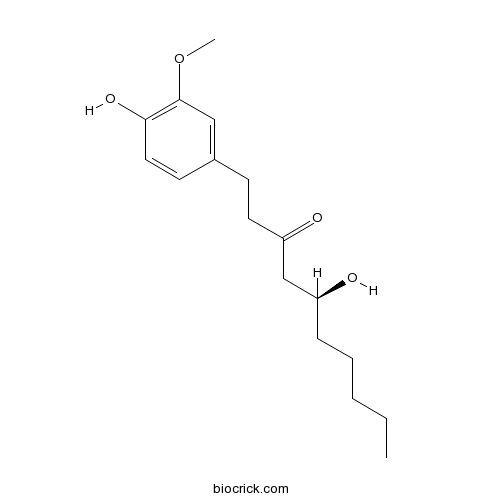A β-hydroxy ketone that is 5-hydroxydecan-3-one substituted by a 4-hydroxy-3-methoxyphenyl moiety at position 1; believed to inhibit adipogenesis. It is a constituent of fresh ginger.
InChI=1S/C17H26O4/c1-3-4-5-6-14(18)12-15(19)9-7-13-8-10-16(20)17(11-13)21-2/h8,10-11,14,18,20H,3-7,9,12H2,1-2H3/t14-/m0/s1
6-Gingerol, a natural product of ginger, has been known to possess anti-tumorigenic and pro-apoptotic activities, it stimulates apoptosis through upregulation of NAG-1 and G1 cell cycle arrest through downregulation of cyclin D1, multiple mechanisms appear to be involved in 6-gingerol action, including protein degradation as well as β-catenin, PKCε, and GSK-3β pathways. [1]
6-Gingerol and 6-shogaol might both exert anti-invasive activity against hepatoma cells through regulation of MMP-9 and TIMP-1, inhibition of the MAPK and PI3k/Akt pathways and NF-κB and STAT3 activities to suppress expression of MMP-2/-9 and uPA and block angiogenesis, and that 6-shogaol could further regulate urokinase-type plasminogen activity.[2,3]
6-Gingerol can repress quorum sensing (QS)-induced genes, specifically those related to the production of virulence factors, inducing exoprotease, rhamnolipid, and pyocyanin.[4]
6-Gingerol has antioxidant and anti-inflammatory activities, it induces genotoxicity probably by oxidative stress; lysosomal and mitochondrial damage were observed in 6-gingerol-induced toxicity.[5]
6-Gingerol has anti-adipogenic activity , can effectively suppress adipogenesis and that it exerts its role mainly through the significant down-regulation of PPARγ and C/EBPα and subsequently inhibits FAS and aP2 expression, also inhibit differentiation in 3T3-L1 cells by attenuating the Akt/GSK3β pathway. [6]
English website: 6-Gingerol
Japanese website: 6-Gingerol
Chinese website: 6-Gingerol
[1] Lee S H, Cekanova M, Baek S J. Mol Carcinogen, 2008, 47(3):197–208.
[2] Chia-Jui Weng, Cheng-Feng Wu, Huang H W, et al. Mol Nutr Food Res, 2010, 54(11):1618–27.
[3] Weng C J, Chou C P, Ho C T, et al. Mol Nutr Food Res, 2012, 56(8):1304-14.
[4] Kim H S, Lee S H, Byun Y, et al. Sci Res-UK, 2015, 5.
[5] Yang G, Zhong L, Jiang L, et al. Chem-Biol Interact, 2010, 185(1):12-7.
[6] Tzeng T F, Liu I M. Phytomedicine International Journal of Phytotherapy & Phytopharmacology, 2013, 20(6):481-7.
[7] Yan D H. Chinese Journal of Pharmaceutical Analysis, 2007, 27(5):733-4.



